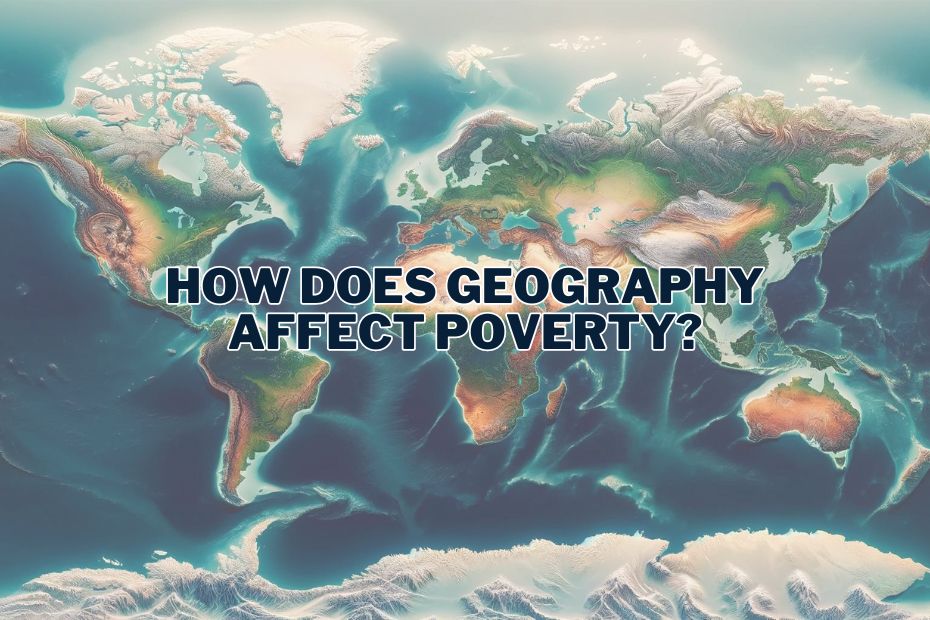Geography plays a pivotal role in influencing various aspects of our lives, and one of the most profound impacts it has is on poverty. In this article, we will delve into the intricate relationship between geography and poverty, exploring how different geographical factors can either exacerbate or alleviate poverty conditions. From the urban-rural divide to environmental challenges, we will dissect how does geography affect poverty levels around the world.
Geography profoundly impacts poverty by shaping access to resources and opportunities. Urban areas often offer better economic prospects, while rural regions may struggle due to isolation and limited services. Additionally, geographical factors like natural disasters and resource distribution can exacerbate poverty levels, highlighting the intricate link between geography and poverty.
How Does Geography Affect Poverty?
Geography, the study of the Earth’s physical features and their spatial distribution, plays a pivotal role in shaping the economic conditions and opportunities available to individuals and communities. It influences not only the access to resources but also the socio-economic and cultural aspects of life. This article examines how geography, through its geographical location, climate, topography, and more, influences poverty.
1. The Impact of Location
Location, Location, Location: It’s not just a mantra for real estate; it’s a fundamental truth when it comes to poverty. Different regions have varying levels of economic development, access to resources, and opportunities. Geographical location directly affects a community’s access to jobs, markets, and essential services, making it a crucial determinant of poverty levels. Remote and isolated areas often struggle with limited access to economic opportunities, pushing residents into poverty.
2. Resource Distribution
Nature’s Bounty: Geography influences the distribution of natural resources such as fertile land, water sources, minerals, and forests. Regions rich in these resources tend to have a more robust economic base, as they can engage in agriculture, mining, and forestry. Conversely, areas lacking these resources may face higher poverty rates as they grapple with limited economic prospects.
Table 1: Resource-Rich vs. Resource-Poor Regions
| Region Type | Economic Prosperity | Poverty Levels |
|---|---|---|
| Resource-Rich | High | Low |
| Resource-Poor | Low | High |
3. The Urban-Rural Disparity
Urban vs. Rural Divide: The divide between urban and rural areas is a key geographical factor influencing poverty. Urban areas, with better access to services, education, and jobs, often see higher living standards. In contrast, rural areas may lack basic infrastructure and opportunities, perpetuating poverty cycles. This disparity is evident in many countries, where rural populations face challenges in accessing education, healthcare, and employment.
4. Topography and Infrastructure
Hills, Valleys, and Roads: Topography directly impacts infrastructure development, influencing poverty levels. Mountainous or flood-prone areas face challenges in building roads, schools, and hospitals, limiting access to essential services. These geographical challenges can isolate communities, hinder economic development, and perpetuate poverty.
5. Cultural and Societal Aspects
Culture and Traditions: Geography also shapes cultural and societal norms, which in turn affect economic opportunities. For instance, communities in remote areas may have traditional lifestyles that limit engagement with broader economic activities. Additionally, societal norms influenced by geography can affect education and employment, especially for women and minorities.
6. Government Policies and Geography
Policy Implications: Governments often design policies based on geographical considerations. For example, regions prone to natural disasters may have disaster relief programs, while remote areas might receive subsidies for essential services. The alignment of government policies with geographical realities can impact poverty alleviation efforts.
Education and Healthcare Facilities
Access to Quality Services: Geography determines the proximity of communities to education and healthcare facilities. Remote areas may lack schools and hospitals, limiting residents’ access to essential services. This educational and healthcare gap can perpetuate poverty cycles.
Conclusion:
In conclusion, geography has a profound and multifaceted impact on poverty. From the unequal distribution of resources to the influence of climate, topography, and government policies, geography plays a pivotal role in determining the economic well-being of individuals and communities. Understanding these dynamics is essential for addressing poverty effectively and promoting equitable development worldwide.
FAQs: How Does Geography Affect Poverty?
Can geography alone explain poverty disparities?
No, geography is just one of many factors that contribute to poverty. Social, economic, and political factors also play significant roles.
Are coastal regions always more prosperous than inland areas?
While coastal regions often have economic advantages, their prosperity can be influenced by various factors, including government policies and global trade dynamics.
How can governments mitigate the impact of geography on poverty?
Governments can invest in infrastructure development, education, and healthcare services in disadvantaged areas to reduce the influence of geography on poverty.
Is there a direct correlation between climate and poverty?
Climate can impact poverty indirectly through its effect on agriculture, food security, and migration patterns.
What role does government policy play in alleviating geographical poverty disparities?
Government policies that focus on equitable resource distribution, infrastructure development, and access to education and healthcare can help reduce geographical disparities in poverty.
